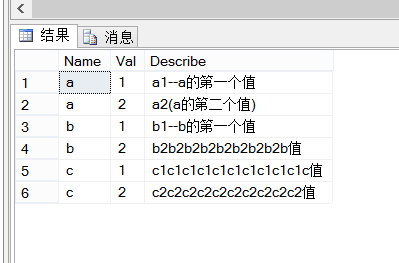sql資料庫實現分組並取每組的前1(幾)條數據 測試數據準備工作: 根據某一個欄位分組取最大(小)值所在行的數據: 創建表並且插入數據 1、根據Name分組取Val最大的值所在行的數據。 Sql語句代碼如下: 上面的5種方法的sql執行執行結果一樣,結果如下圖: 2、根據Name分組取Val最小的值 ...
sql資料庫實現分組並取每組的前1(幾)條數據
測試數據準備工作:
根據某一個欄位分組取最大(小)值所在行的數據:
創建表並且插入數據
CREATE table Test_orderByOrGroupBy_tb(Name nvarchar(50),Val int,Describe nvarchar(50)) insert into Test_orderByOrGroupBy_tb values('a', 1, 'a1--a的第一個值') insert into Test_orderByOrGroupBy_tb values('b', 2, 'b2b2b2b2b2b2b2b2b值') insert into Test_orderByOrGroupBy_tb values('a', 2, 'a2(a的第二個值)') insert into Test_orderByOrGroupBy_tb values('b', 1, 'b1--b的第一個值') insert into Test_orderByOrGroupBy_tb values('a', 3, 'a3:a的第三個值') insert into Test_orderByOrGroupBy_tb values('b', 3, 'b3:b的第三個值') insert into Test_orderByOrGroupBy_tb values('c', 1, 'c1c1c1c1c1c1c1c1c1c1c值') insert into Test_orderByOrGroupBy_tb values('b', 5, 'b5b5b5b5b5b5b5b5b5b5值') insert into Test_orderByOrGroupBy_tb values('c', 2, 'c2c2c2c2c2c2c2c2c2c2值') insert into Test_orderByOrGroupBy_tb values('b', 4, 'b4b4b4b4b4b4b4b4b值') GO

1、根據Name分組取Val最大的值所在行的數據。
Sql語句代碼如下:
--方法1: select a.* from Test_orderByOrGroupBy_tb a where Val = (select max(Val) from Test_orderByOrGroupBy_tb where Name = a.Name) order by a.Name --方法2: select a.* from Test_orderByOrGroupBy_tb a,(select Name,max(Val) Val from Test_orderByOrGroupBy_tb group by Name) b where a.Name = b.Name and a.Val = b.Val order by a.Name --方法3: select a.* from Test_orderByOrGroupBy_tb a inner join (select Name,max(Val) Val from Test_orderByOrGroupBy_tb group by Name) b on a.Name = b.Name and a.Val = b.Val order by a.Name --方法4: select a.* from Test_orderByOrGroupBy_tb a where 1 > (select count(*) from Test_orderByOrGroupBy_tb where Name = a.Name and Val > a.Val ) order by a.Name --其中1表示獲取分組中前一條數據 --方法5: select a.* from Test_orderByOrGroupBy_tb a where not exists(select 1 from Test_orderByOrGroupBy_tb where Name = a.Name and Val > a.Val)
上面的5種方法的sql執行執行結果一樣,結果如下圖:

2、根據Name分組取Val最小的值所在行的數據。
--方法1: select a.* from Test_orderByOrGroupBy_tb a where Val = (select min(Val) from Test_orderByOrGroupBy_tb where Name = a.Name) order by a.Name --方法2: select a.* from Test_orderByOrGroupBy_tb a,(select Name,min(Val) Val from Test_orderByOrGroupBy_tb group by Name) b where a.Name = b.Name and a.Val = b.Val order by a.Name --方法3: select a.* from Test_orderByOrGroupBy_tb a inner join (select Name,min(Val) Val from Test_orderByOrGroupBy_tb group by Name) b on a.Name = b.Name and a.Val = b.Val order by a.Name --方法4: select a.* from Test_orderByOrGroupBy_tb a where 1 > (select count(*) from Test_orderByOrGroupBy_tb where Name = a.Name and Val < a.Val ) order by a.Name --其中1表示獲取分組中前一條數據 --方法5: select a.* from Test_orderByOrGroupBy_tb a where not exists(select 1 from Test_orderByOrGroupBy_tb where Name = a.Name and Val < a.Val)
上面5種方法執行結果是一樣的,如下圖:

3、根據Name分組取第一次出現的行所在的數據。
select a.* from Test_orderByOrGroupBy_tb a where a.Val = (select top 1 val from Test_orderByOrGroupBy_tb where a.Name = a.Name) order by a.Name
執行結果如下圖:

4、根據Name分組隨機取一條數據
select a.* from Test_orderByOrGroupBy_tb a where a.Val = (select top 1 Val from Test_orderByOrGroupBy_tb where Name = a.Name order by newid()) order by a.Name
運行幾次執行結果如下圖:



5、根據Name分組取最大的兩個(N個)Val
--方法一: select a.* from Test_orderByOrGroupBy_tb a where 2 > (select count(*) from Test_orderByOrGroupBy_tb where Name = a.Name and Val > a.Val ) order by a.Name,a.Val --方法二: select a.* from Test_orderByOrGroupBy_tb a where val in (select top 2 val from Test_orderByOrGroupBy_tb where Name=a.Name order by Val desc) order by a.Name,a.Val --方法三: SELECT a.* from Test_orderByOrGroupBy_tb a where exists (select count(*) from Test_orderByOrGroupBy_tb where Name = a.Name and Val > a.Val having Count(*) < 2) order by a.Name
上面的三種方法執行結果是一致的如下圖:

6、根據Name分組取最小的兩個(N個)Val
--方法一: select a.* from Test_orderByOrGroupBy_tb a where 2 > (select count(*) from Test_orderByOrGroupBy_tb where Name = a.Name and val < a.val ) order by a.name,a.val --方法二: select a.* from Test_orderByOrGroupBy_tb a where val in (select top 2 val from Test_orderByOrGroupBy_tb where name=a.name order by val) order by a.name,a.val --方法三 SELECT a.* from Test_orderByOrGroupBy_tb a where exists (select count(*) from Test_orderByOrGroupBy_tb where Name = a.Name and val < a.val having Count(*) < 2) order by a.name
上面的三種方法執行的結果一致如下圖:



